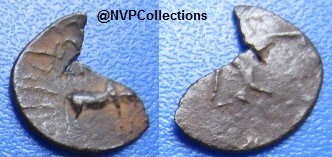Saturday, January 19, 2013
Sunday, January 13, 2013
BANAVASI COINS
Banvasi is old temple town in Utharakannada district and karnataka state. It is one of the oldest place in Karnataka. The town was ruled by Kadamba dynasty. Kadamba ruler ruled this place for at least two centuries from AD 345 to 525.They ruled northern Karnataka and konkan. The Kadamba dynasty was founded by Mayurasharma in year 345 CE.
Before Kadamba era Karnataka was ruled by the Mauryans, Satavahanas and Chutus were not native of Karnataka. The Kadambas were the first dynasty to use Kannada language in administrative level.
CHUTU DYNASTY COINS
Time : 30 BC - 70 AD
Metal : Lead
Obverse : 8 arched hill with river below, Legend - "Rajno Chutukilananda"
Reverse : Tree in complex railing of 12 squares
Ruler : Chutukalananda
PREKADAMBA COINS
Time : Prekadamba (Before AD 345)
Metal : Potin
Obverse : Bull Facing Left/Right and Brahmi Inscription
Reverse : Symbols of Bow. Arrow and Wheel
Ruler : Unknown
KADAMBA EMPIRE
 |
| KADAMBA SCRIPT LETTERS |
Ruler : Krishnavarma II
Year : AD 516 - 540
Obvesre : Circle divided in to 5 wedges, kannada letters within "Sri Do sha ra shi"
Reverse : Kannada letters "Sha Shan kah", shashanka means moon in sanskrit
Weight : 0.28 grams
Diameter : 11 mm
Metal : Potin
Ref : Coins of Banavasi by K Ganesh
Chakra Type Coins
Chakra type uniface potin unit
Type : 4 spoke chakra
Weight : 0.4 grams
Metal : Potin
Type : 4 spoke chakra within dotted border
Weight : 0.4 grams
Metal : Potin
Conch Type Coins
Type : Conch within dotted border
Weight : 0.15 grams
Metal : Potin
Wednesday, January 2, 2013
NUMISMATIC DICTIONARY
Anna -
A copper coin of India, the sixteenth part of a Rupee. It is sub divided
into four Pice or twelve Pies. It is referred to early in the eighteenth century
by A. Hamilton, in A New Account of the East Indies
1727, who states that "In Bengal their accounts are kept in Pice, twelve
to an Annoe, sixteen Annoes to a Rupee.
Dime - A coin of the United states
Karshapana - The name of both Copper and Silver denomination in the coinage of Ancient India.
Kori - The standard currency of Kutch, It is a small silver coin of the average value of 4 Annas or one fourth of Rupee.
Tanga - Silver or Copper coin of the Portugeese India, struck principally at Goa with a value of 60 Reis. It appears to have been issued early in 17th century.
Billon - Base metal usually obtained by
mixing silver and copper. In reality it
may contain more than 50% copper. If the
proportion of copper is more than 75%, then such metal is called as Black
billon.
Cash - The English word for Indian words Kas or
Kasu. The word cash is used on the copper coins of Mysore
Cent - It is the name of copper coins
of the United states of America
Centavo - A copper coin of Mexico , Central America and many countries of South America . It is almost uniformly the one hundredth
of Peso.
Centime - A Copper coin, the one hundredth
of the Franc. It is used in France
and France
Centimo - A spanish equivalent of Centime.
In Spain
Chakram or Chukram - A silver coin of Travancore state issued in eighteenth century and later.The Chukram is equal to 16 copper Kas and is fourth part of Fanam.
Dinar - A money used in modern Persia
Dinglo - A Copper coin of Kutch and Kathiawar with Value of one sixteenth of Kori. The term Dinglo means "something fat" or "fattest coin"
Duddu - Also known by name Dudu, Doudu and Tuttu. A copper coin of Southern india, the value of which varied according to the locality.
Falus or Faluce - A copper coin of Madras issued early in eighteenth century and of the value twenty cash or Kas
Fanam - A name given to both gold and silver coins which are common in south india. Gold fanam is a minute coin circulated in Travancore and on the Malabar coast. Silver fanam probably originated at the Bombay mint in the 17th century. In the coinage of early India the fanam was a gold coin weighing over five grains and equal to tenth part of the Pagoda.
Karshapana - The name of both Copper and Silver denomination in the coinage of Ancient India.
Kasu - Kannada word for Cash, Its used in Mysore state.
Kori - The standard currency of Kutch, It is a small silver coin of the average value of 4 Annas or one fourth of Rupee.
Mohur - A gold coin of India. It was introduced during Moghul in the sixteenth century. The name is from Arabic
1 Mohur = 3 Fanams
= 15 Rupees
= 240 Annas
= 1500 Pice
Pagoda - A name given to both Gold and Silver coin in Madras and many parts of Southern India. The Tamil name for Pagoda is Varaha. The modern Pagoda can be traced to the early part of seventeenth century and varieties are The Lakshmi, The Swami, The star etc. The divisions of Pagodas are usually computed as follows:
20 Kas = 1 Fels
4 Falus = 1 Fanam
42 Fanams = 1 Pagoda
Pavali - Silver coin (1877) of value of one quarter of Rupee was circulated in Mysore.
Pice - Coin was mentioned in Bombay during seventeenth century. It was generally accepted as equal to fourth part of Fanam and 100 pice equal to one Rupee.
Rupee - Also Called Rupih or Roupie. 16 annas and 100 pice equal to one Rupee.
Tanga - Silver or Copper coin of the Portugeese India, struck principally at Goa with a value of 60 Reis. It appears to have been issued early in 17th century.
Subscribe to:
Posts (Atom)




















